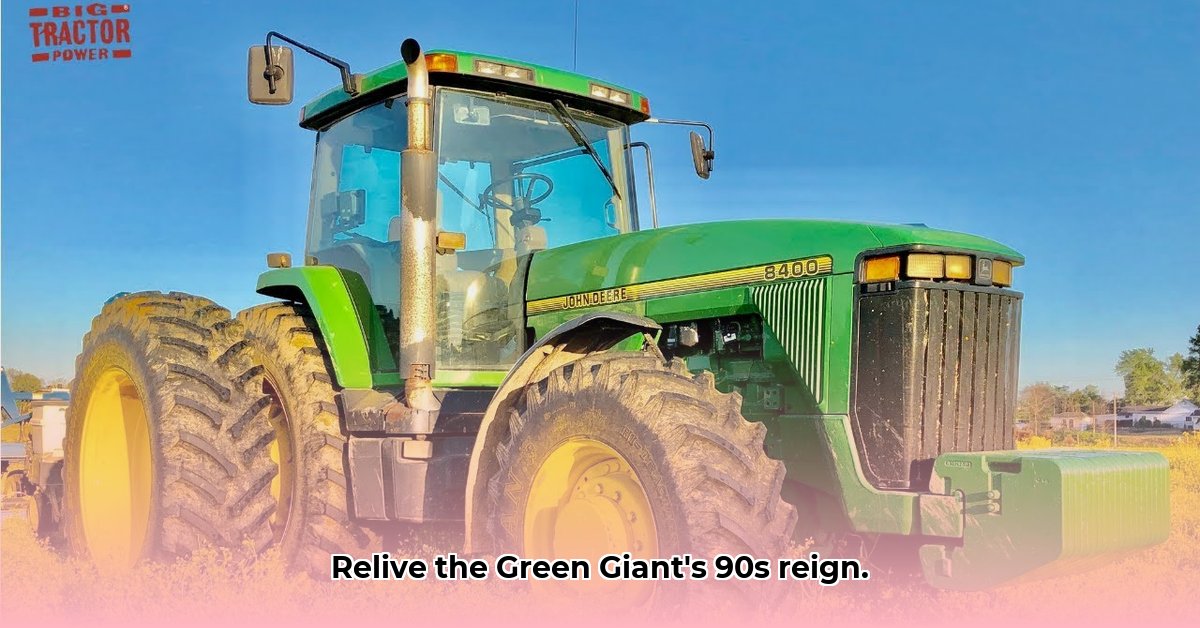
The 1990s witnessed a quiet revolution in agriculture. While the world embraced dial-up internet and grunge music, a technological transformation was underway in the fields. John Deere tractors, in particular, spearheaded this change, ushering in an era of unprecedented efficiency and precision farming. This article explores the innovations of these machines, their impact on farmers' lives, and their enduring legacy in shaping modern agriculture's sustainable future. To learn more about earlier John Deere innovations, check out this page on earlier models.
A Decade of Dramatic Technological Leaps
What set 1990s John Deere tractors apart? The answer lies in several key areas. Engine technology saw significant advancements, delivering more power while consuming less fuel. This meant farmers could cultivate larger acreages daily, leading to increased yields and reduced operational costs. But it wasn't just about horsepower; the incorporation of electronic controls marked a significant shift. Automatic transmissions and advanced hydraulic systems made operation smoother, less physically demanding, and ultimately more efficient. How much did fuel efficiency improve? While precise figures for individual models are difficult to pinpoint, the overall trend toward fuel economy was undeniable and fundamentally reshaped farming practices.
Transforming Farming: More Than Just Machines
The impact extended beyond mere statistics. For farmers, the transition to these new tractors represented a significant improvement in quality of life. Operating older models was physically strenuous; the 1990s John Deere tractors alleviated this strain, allowing for longer, more productive workdays without the same level of physical exhaustion. This wasn't just about efficiency; it was about increased comfort and improved well-being for those who dedicated their lives to cultivating the land. Did you know that studies have shown a direct link between improved ergonomic design and reduced operator fatigue? This is a testament to the holistic impact of these technological advancements.
Precision and Productivity: A New Era of Farming
The precision offered by these tractors was revolutionary. Farmers could now plant seeds and apply chemicals with unprecedented accuracy, minimizing waste and maximizing resource utilization. This resulted in significant cost savings and reduced environmental impact—a substantial win-win scenario. The increased yields also contributed to feeding a rapidly growing global population. This precision wasn't just a technological marvel; it represented a paradigm shift toward sustainable agricultural practices, a trend that continues to gain momentum in the current agricultural landscape.
Notable Models: Icons of Innovation
While pinpointing every significant model is impossible, several series stand out as exemplary embodiments of this technological leap. The 4000 series, for instance, was a powerful symbol of the industry's rapid transformation. The 7000 and 8000 series further solidified John Deere's commitment to pushing the technological envelope. These tractors represented more than just advancements in machinery; they were statements of intent, highlighting a clear vision for the future of farming. How did these models specifically contribute to the increased efficiency and productivity discussed earlier? This is a topic worthy of further research and analysis.
A Glimpse into the Future: Sustainability's Roots
Interestingly, by analyzing the 1990s John Deere tractors, we gain valuable insight into the current focus on sustainable agriculture. The improved fuel efficiency, for example, directly foreshadowed today's emphasis on environmentally friendly farming practices. Although sustainability wasn't a primary design consideration during this decade, the tractors' inherent efficiency laid the foundation for more eco-conscious machinery. Their contribution wasn't simply economic; it was also fundamentally environmental.
The Enduring Legacy: Shaping Modern Agriculture
The John Deere tractors of the 1990s represent more than just a technological breakthrough; they mark a pivotal moment in agricultural history. They were instrumental in shaping the future of farming, and their influence is deeply embedded in the practices we see today. Their advancements paved the way for the even more sophisticated and sustainable agricultural tools of the present. What future innovations in agricultural technology might we expect, building on the legacy of these 1990s tractors? This is a question that deserves ongoing discussion.
Key Innovations of 1990s John Deere Tractors
| Feature | Description | Impact |
|---|---|---|
| Enhanced Engines | More powerful and notably more fuel-efficient engines. | Increased acreage coverage, reduced fuel costs, higher yields. |
| Electronic Systems | Advanced automated transmissions and sophisticated hydraulic systems. | Improved operator comfort, increased efficiency, reduced physical strain on farmers. |
| Precision Enhancements | Improved accuracy in seeding and spraying capabilities. | Reduced resource waste, cost savings, and environmental benefits. |
This table highlights just some of the key advancements that distinguished 1990s John Deere tractors, significantly impacting farming practices. Ongoing research continues to refine our understanding of these tractors and their extensive, long-term effects on the agricultural industry.